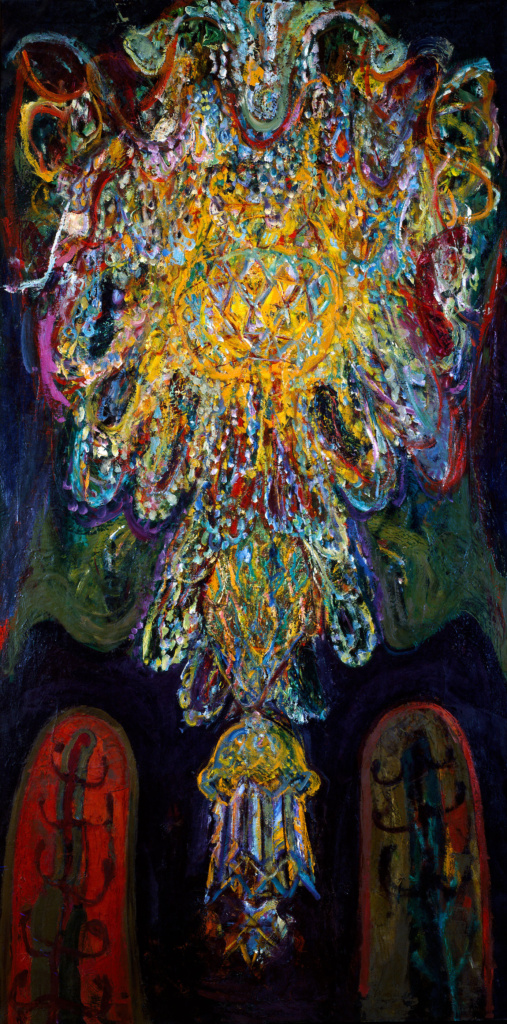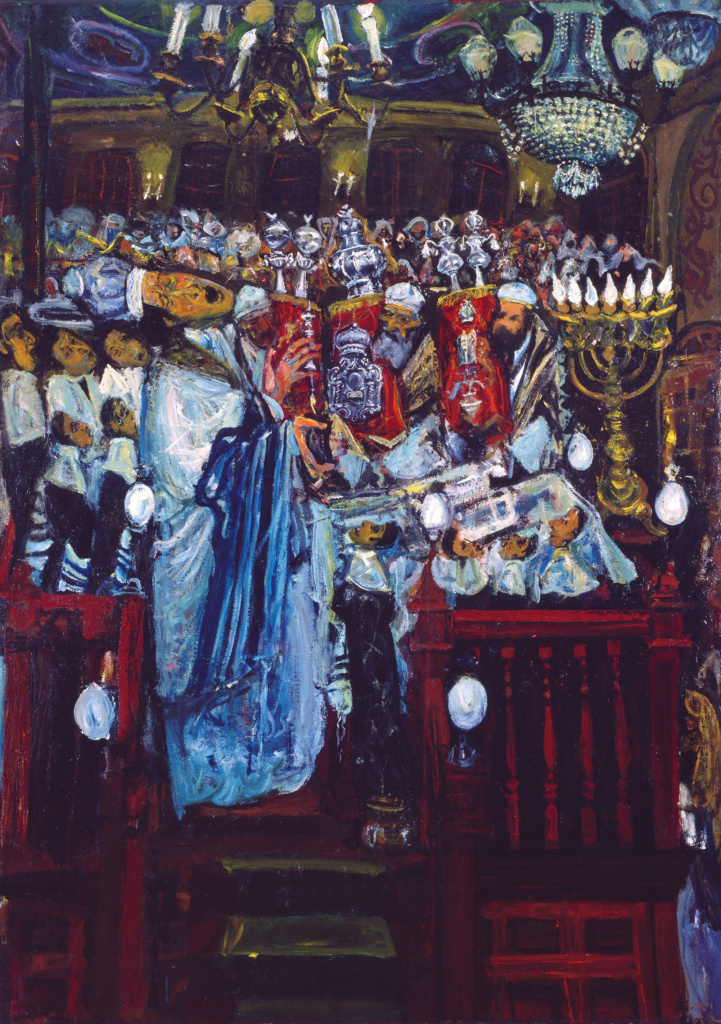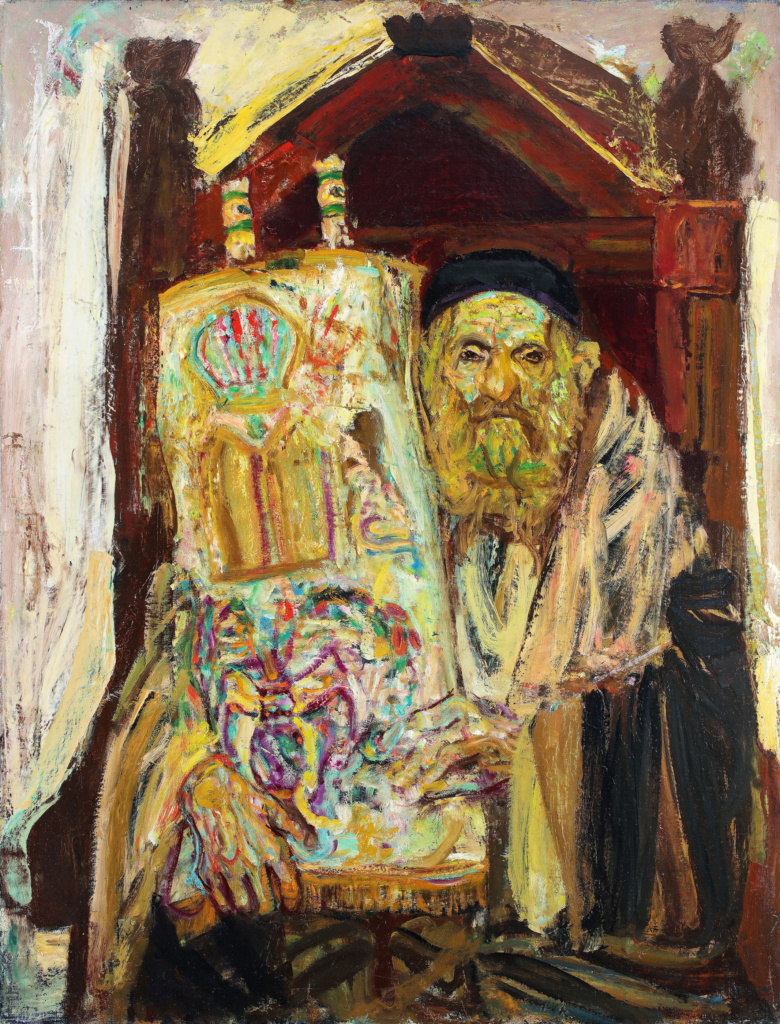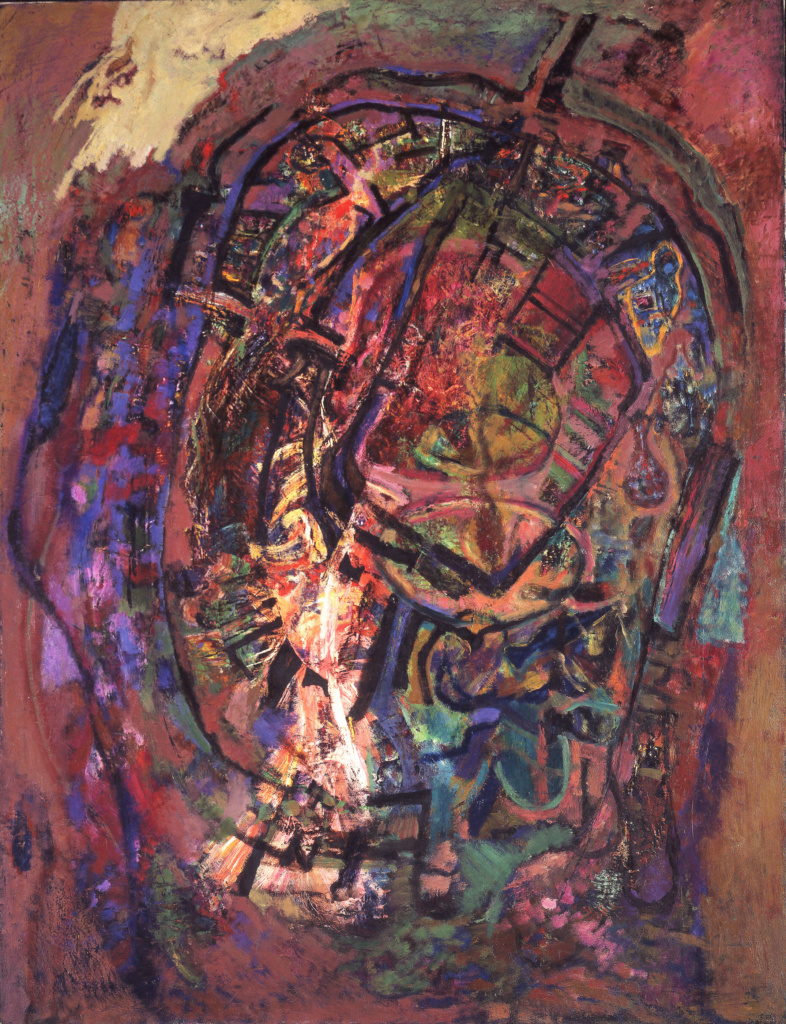4 BOSTON MASTERS
Boston Museum of Fine Arts, April 10 - May 11, 1959
Published by MFA Publications, an imprint of the Museum of Fine Arts, Boston. © Museum of Fine Arts, Boston and Wellesley College. Reproduced with permission.
An Introduction
There can be little question that the most significant painter in Boston today is Hyman Bloom. Despite his small output (he works slowly) and his natural reticence (he shuns publicity), he is widely recognized as an artist of extraordinary imagination, feeling and power. Eight American museums already own Blooms: the Museum of Modern Art and the Whitney in New York, the Boston and Chicago museums, and the academic galleries of Andover, Harvard, Smith and Wellesley. Boston can rightfully claim him, for he has lived here since he was seven, and has left only for brief trips to Maine, New York and the West Coast. Despite his Baltic birth he has spent a greater proportion of his life here — including his whole painting career — than Copley, Allston or Prendergast. He has taught here, at Wellesley and Harvard. So many of his pictures have gone into private collections in or near Boston that people in other cities, except New York, have had little opportunity to know his work well.
Although trained primarily as a draughtsman he has become the most “painterly” of painters. His knowledge of techniques is precise and extensive. Few living artists can approach him in the variety, splendor and intensity of the effects he obtains with paint. For the particular quality of paint he wants, denser and less slippery than that which comes ready-made in tubes, he regularly mixes his own: dry pigment in more-or-less equal parts of dammar varnish and thick stand oil. Before it has entirely dried he often goes over the first underpainting with more paint, working it into the old and varying the color from stroke to stroke. After this has dried as hard as marble he may float glazes over parts of the picture, sometimes film after film. He avoids the glossy Venetian varnish glaze for a “drier” kind, made of his own prepared paint thinned with turpentine. Occasionally after the canvas has been encrusted with several layers of color he will slice through them with a knife, so that sections of the varied thin layers will coruscate like a shattered shell or a cut of onyx. The varied surfaces can appear luminous, glassily hard, viscid, vaporously soft, or take on almost any quality he wants. This does not make a mere virtuoso technical display, however, for as Mrs. Saarinen shows in her essay, the very paint is transmuted into a bearer of profound feeling. Bloom usually paints by artificial light. He never paints or draws from life but always from memory or invention. His first teacher made him draw very precisely from memory, an invaluable discipline he steadily maintains. (He taught his students at Wellesley and Harvard to work the same way. Many were surprised, having come with boxes of the brightest paints with which to express themselves “expressionistically.”)
Hyman Bloom is, happily, still very much alive, and it is early for art historians — whom he may wryly regard much as his own Harpies — to pick at his artistic relations to Boston and Boston’s to him. Both are broader and more complex than in the case of the earlier masters in this exhibition. One reason is surely that our Boston is not the same. Although Bloom comes from Baltic Jewish stock, and Prendergast from Irish, neither felt himself an exotic transplanted to a foreign city, for to old New England Boston there have been added in the last century the vast communities of Irish Boston, Italian Boston, Jewish Boston and many more. While Copley once conveyed what we believe to have been the essential character of his city, Bloom does not, for Boston no longer has such a homogeneous — or limited — character. Although he lives in a far bigger world than Copley, he makes us feel it as intensely. In a profoundly moving and personal way Hyman Bloom expresses what one sensitive, thoughtful and humane man feels when confronted with some of the realities of our world, bearable and unbearable. Without roots in that world, he could do this only superficially, but his deep roots in Boston are double: in the stern Jewish Orthodoxy transplanted here two or three generations ago, and in the not dissimilar Puritan orthodoxy already here for some twelve. He is aware of this harmonious duality of two Old Testament faiths, and it is one of the sources of his strength. Both beliefs are not merely local: they are but our branches of something that extends into certain vast reaches of space and time where man has lived, felt and thought most profoundly.
JOHN MCANDREW
Hyman Bloom
The work of Hyman Bloom — like that of any serious and personal artist — is concerned with one dominant theme. The subject matter may vary, the pictorial means alter, the metaphors differ, the range run from the simple to the richly complex, but what the artist is saying about life is constant. It must be: the serious and inward artist is concerned only with expressing his own response to the universe and that response, generated by a fusion of temperament and circumstances, both large and small, may expand, deepen or otherwise develop — but it does not change.
The apparent and official subject matter — the pictorial images of a painting — tell one story, so to speak, and make their own impact. Out of the vast potential raw material which the artist explores, out of a hundred thousand possibilities — at a given moment in his life and development these are the particular images that move him. They mesh with an interest or a circumstance, with an idea, an emotion, or even an obsession.
Beyond this, these particular images become stimuli for his pictorial imagination. They coincide with his way of seeing which becomes, of course, his way of painting or drawing. They allow themselves to be transformed into the kinds of color relationship, the kinds of interacting or opposing forms, the kinds of tension or serenity of space, the kinds of internal-order-out-of-chaos by means of which the artist speaks. But surely a large part of the power of these subjects to attract him and hold him is their capacity to express the other story, the dominant and recurrent theme that may communicate itself directly or may run like a subterranean stream beneath the surface.
Hyman Bloom’s preoccupation is metamorphosis. More accurately, since he is concerned not with transformation but with transforming, not with become but with becoming, one should use — ugly as it is — the active form of the word: metamorphosing.
In a general and over-simplified way, Bloom’s “official” subject matter can be divided into four parts: the religious themes, the seance series, the corpse, old age and beggar themes, and the animal and nature themes. Each has had logical appeal to him in terms of temperament, character and environment. Each has held powerful stimulus for his pictorial imagination, for each is rich in its capacity of being transformed into an appropriate pictorial means of expression. All of them are related and all allow the dominant, underlying theme of metamorphosis to manifest itself.
Before we examine his work in terms of these four general themes and in terms of its expression of his basic philosophic preoccupation, it is important to know something of his artistic evolution and sensibilities.
With Jack Levine, who lived in the same West End slum district of Boston, Hyman Bloom began attending settlement-house art classes in 1926, when he was thirteen. Both the boys studied with the painter Harold Zimmerman for about six years and went through rigorous discipline in drawing for which they both had rare talent. Bloom remembers Zimmerman as an inspired teacher who encouraged his students to work from memory and imagination but at the same time insisted that they execute their visions according to standards of mature excellence. He apparently also taught them the importance of acute observation, a discipline which neither has lost.
Both the youths also came under the influence of Denman Ross, a dedicated amateur, collector, painter and benefactor of the Fogg Art Museum and the Boston Museum of Fine Arts. Dr Ross taught them theories of color, hired studios in which they could work with Zimmerman, and gave them each a stipend of twelve dollars a week. Perhaps even more significantly, Ross introduced them to the art of the past. Bloom’s first enthusiasms were the paintings of Caravaggio and Rembrandt, and the drawings of Blake, Botticelli, Leonardo and Durer.
Zimmerman introduced them also — when Bloom was eighteen — to the art of the present. On a trip to the Museum of Modern Art in New York, young Bloom discovered Rouault, Soutine and Chagall.
Perhaps the discipline of six years spent only in drawing made Bloom immune to the melodramatic aspects of expressionist art — the custard-thick impasto, the over-excited brushstrokes, the uncontrolled bravura; or perhaps it was the introspective, moral-philosophic cast of his character that saved him from those aspects of expressionism that seem to belong to the artistic voluptuaries. Bloom did copy Rouault for a while, but except for an abiding love for resonant, splendid color his inheritances from his early artistic enthusiasms are indirect rather than direct. His own pictorial means of expression evolved in the late thirties and though they have developed with increasing subtlety and forcefulness they have remained consistent. Bloom aims for a contained intensity. In the paintings color is of course a prime agent toward this end. So too is the way he handles space. He treats it as a very narrow slice directly on the picture plane. He up-ends and flattens images to keep them within this deliberately cramped Lebensraum and thus heightens the immediacy between picture and spectator. His compositions are not built on static, structural frameworks but achieve their unity through a revolving, wheel-like motion around a focal hub.
For Bloom, painting and drawing are different means of expression. Although the spatial concepts, the rhythms and the method of unifying are constant in both his paintings and drawings, he never confuses line with brushstroke. Furthermore, the subjects which stimulate him to rich, robust expression in paint are, as we shall see, always different from those that find their expression in the more tense medium of drawing.
That Hyman Bloom should have been attracted to religious themes is scarcely odd. Born near Riga, Latvia, in 1913 and brought to Boston at the age of seven, he felt his Orthodox Jewish background an insistent part of his early life. (Although it is rarely recognized, this fierce, demanding, moralistic religion—with its terrifying God of Wrath—leaves as lasting and inescapable an impact on a child as does a strict Catholic upbringing.) However, when Bloom turned to religious subjects he paid no attention to the fierce and unremitting aspects of the Jewish faith. Accelerated by other circumstances, these were to find their outlet elsewhere. Within the realm of religious subject matter, he concentrated instead on the Byzantine splendor of the ceremonies and symbols and on their mystical implications.
These aspects coincided both with the idiosyncracies of his temperament and with his artistic sensibilities. All the essential elements of his way of painting are manifest in the pictures of religious subjects done in the late thirties and early forties when Bloom and Levine—off and on, on and off the various CWA and WPA projects—moved into a house in the South End of Boston and became part of a fervent young Boston Bohemia. It was these paintings of religious subjects which so impressed Dorothy Miller of the Museum of Modern Art that she chose Bloom for her show of discoveries: “Americans 1942.”
Religious themes are, indeed, the “official” subjects of these pictures. The chandeliers and the Torahs, the candelabra and the prayer cloths sparkle against the rich blue-green-tawny tones of the congregation. The brushstrokes, like the color, set up a vibrating rhythm, as we can vividly see in his presentation of the spectacular ceremony in The Synagogue. The underlying theme is here, too, for the giant rabbi and the little choir boys, straining their necks in disquieting attitudes of concentration, are becoming part of the sonorous splendor of sound through which man and God are joined—which is what the picture is really about.
The “official” subject of some early oils — painted with a mysterious blue-green shimmer — and of some late, more convincing gouaches is Old Man with Torah. But the old men cradle the Torahs as tenderly as ever a Virgin held The Child and, indeed, the rolls of Scripture seem strangely to be becoming incarnate objects, until the line of identity between man and symbol is blurred. When Bloom comes with close focus up to the Chandeliers, which had been only details in the brutalities imposed on the Jews. Perhaps, too, even more vividly and immediately, he had been made aware of the insecurity of life, the presence of violence and the nearness of death in the tenement district in which he had spent the years of his childhood. (In his teens he usually chose themes of violence and agony for his drawings, such as Absalom slain as he hung by his hair from a tree, or Prometheus with the eagle devouring his liver.) It was inevitable that some time his morbid concern with death would express itself directly in pictorial terms.
There are two paintings of The Bride which are usually thought related to the religious subjects. The disciplined whirlwind of dazzling light and jewelled richness of color in the standing Bride recalls the symbolic Chandeliers, and the critic Clement Greenberg believes that since the bride “is one of the chief personifications of the Sabbath” Bloom has so intended the subject. But if one looks at these paintings in relation to the later series of corpses, I think one sees them as prophecies. Which slumber — the sleep of life or the sleep of death — does the recumbent Bride sleep? Both, perhaps. The sparkling ceremonial robes of the standing Bride enclose and frame her in a manner not too different from the way the white sweep of shroud frames the Female Corpse, Back View.
But without some special impetus, Bloom’s preoccupation with death and violence might not have found expression in the painting of corpses. That impetus was double. He told his friend Freedberg that the war seemed to him “a realized nightmare.” Halfway through the war, he visited a dissecting room. The encounter “focused his accumulating obsession into a concrete, immediately visible form: decaying corpses became the visual symbols where a major concern of his private psyche and a general comment on the world at war converged.”
(In this connection, it may be illuminating to know that during the war, Willem de Kooning, an artist totally unlike Bloom, once passed a butcher shop and was frozen by the sight of a piece of bloody beef held aloft by a huge, cruel-looking, black hook. It moved him as an arresting visual symbol of the brutality of war about which he had been brooding, and impelled him to paint a savage picture of protest. His pictorial imagination was stimulated not by the image of the beef but solely by his reaction to it and there is not one reference to beef or hook in his painting.)
For Bloom, the carcasses and severed limbs in the autopsy room so coincided with feeling and with pictorial imagination that these dreadful objects became the “official” subject of the paintings. The amputated Leg, grandly and awesomely presented on its table like some pagan sacrifice on an altar, and the paintings of Corpses (including one with the black harpies of war plucking at it) are the direct consequence of the experience in the dissecting room. They are extraordinary paintings. The poor corpses have the same awkwardness of posture as The Bride — an awkwardness that somehow increases the pathos of their condition, rudely exposed and helplessly subject to impersonal dissection. The shallow layer of space in which Bloom confines his images is used brilliantly in these pictures and heightens the sense — almost hypnotic — of the spectator’s immediate presence.
Although less gangrenous than the Leg, the corpses are no less surely decaying. But here, magnificently, metamorphosis makes itself felt in its most somber and moving expression, for flesh is transformed by passages of incredible beauty, of luminous iridescent color and subtly mottled textures. In the rotting flesh of death, we see the beauty of primeval organic life.
If the decaying hole in the Leg or the flesh of the Corpses were isolated and enlarged, their similarity to Treasure Map would be apparent. They share the same coloristic richness and complex rhythms of interacting forms. The persistence of organic processes and the eternal cycle of death and life are pictorially affirmed. And for both, destruction and growth, the visual paraphernalia which stands in Bloom’s studio and which stocks his visual memory — peacock feathers, polished abalone shells, butterflies, semi-precious stones, old glass, medical color-plates, bits of cloth—inspire and enrich the imagery of both these subjects.
It is not surprising that Bloom, concerned with the supreme metamorphosis of life into death and death into life, should have become interested in the very old who stand on the threshold of both. This fascination expressed itself in a series of drawings of crones, where the terrible and pathetic dissolution of body and mind are revealed; sometimes in drawings with pencil strokes whose expressive agitation is consummately controlled, sometimes in drawings where white lines of infinite delicacy spin a magic, form-creating web on dark paper. Related to these is the series of drawings of beggars, but while the crones linger resignedly in the moments between life and death, the old men beg for life, some with vacant and some with fierce eyes, some with mute pleading and others with yelling demand. The draughtsmanship itself here seems angrier, sharper and more violent.
The fourth group of Bloom’s “official” subjects is drawn from the world of animals and nature. There are, for instance, his invented animals: the dragons, beyond doubt fantastic symbols of war. There are also the Fish drawings. The artistic attraction of the “official” subject of swimming fish with live, heads and skeletal bodies is obvious. The iridescent heads and the lacy tracery of the skeletons are the kind of visual wonders that attract him. Pictorially, the subject has also allowed him to weave the magic of his white lines over the depthless surface with a special tension and to create his favorite kind of rhythmic clockwise motion. Beyond this, the pictorial expression could communicate unequivocally the persistent theme of metamorphosis — for these creatures are both living and dying, continuously emerging from the watery element in which they move and continuously disintegrating back into it.
In the Treasure Map Bloom painted the splendor of the organic life of the earth. In a more recent painting, Autumn Leaves, the metaphor shifts and the style is broader, bolder, and freer — but metamorphosis is still there. The fallen and blowing leaves are still brilliant with the color of their last moments of life on the tree. Just beginning their decay and mouldering, they will enrich the earth again in the continuity of the organic process.
Autumn Leaves is as close as Bloom has yet come to a painting of landscape, though he once made several pure landscape drawings after a visit to Maine. Predictably, Bloom would be attracted by the metamorphosing aspects of nature. But also, predictably for an artist of his introspective temperament and for one who grew up in a city, it would not be the serene and pastoral aspects of nature which would engage him but the mysterious, unsubdued ones. In this he is related to those expressionist artists of the past such as Grunewald and Altdorfer who, as Sir Kenneth Clark says in his perceptive book on Landscape Painting, “knew that the human mind was full of darkness, twisted and fiery, and they painted an aspect of nature which expressed these dark convolutions of the spirit, just as the backgrounds of Piero della Francesca had expressed the clarity of the intellect.” Thus, their landscape art — and Bloom’s — “prolongs, both in its imagery and in its complex rhythms the restless, organic art of the folk-wandering period” — an art born of forest fears.
“The last symbol of these old German obsessive fears,” says Clark, “tamed and domesticated by a century of materialism, is the Christmas tree.” Bloom painted his Christmas Tree, like his Chandeliers, as a religious ceremonial symbol. It already has the shaggy, ragged forms that he again found fascinating in the forests of Maine. Clark also quotes the passage from Beowulf describing Grendel’s Mere, because it describes almost all the elements that persistently recur in those landscapes where the artist is interested in the mysterious, untameable, organic processes of nature:
“In a doubtful land
Dwell they, wolf-shapes, windy nesses,
Fearsome fen-paths, where the force from the mountains
Under misty nesses netherwards floweth,
A flood under the fields. ‘Tis not far from hence
As miles are marked that the mere standeth,
Above which hang rimy bowers;
A wood fast-rooted the water o’er-shadows.
There will, every night, a wonder be seen,
Fire in the flood…….”
And for Bloom, decay and growth, death and life, metamorphosis— the wonder to be seen, and to be painted and to be drawn.
Thus, Bloom’s work is rich in what Keats called “entanglements and enrichments.” I have attempted to show something of the multiple levels, both pictorial and philosophic, of his art. What gives his work its power is the way in which the complexities are unified into forceful and realized pictorial expression. He seems to me unquestionably one of the most significant and provocative artists of our time.
ALINE B SAARINEN






